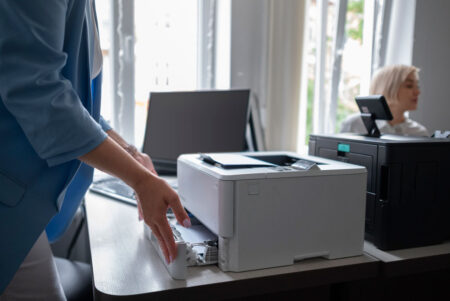There are many types of printer ink and toner. Knowing the differences among them can help you find the right printer for your home office.
If you’re in the market for a new printer for your business or home office, it can be difficult to know where to look. Then, once you have decided on a printer, you need to know which type of printer ink to get. This depends on many factors, including color quality, efficiency and cost. If you’re deciding which printer ink you should invest in for your multifunction copy machine, here’s a brief overview of each type.
Types of printer ink
There are various printer inks, each with its own printing style and price point. Knowing the differences between the types of ink can help you determine which type of printer to buy and what ink or toner to use regularly. Here are the most common types of general print ink:
- Liquid ink: Used by inkjet printers, liquid ink is sprayed as microscopic droplets onto the paper to form an image. Using liquid ink and ink-based printers gives you the ability to print more vivid colors than laser printers can.
- Dye-based ink: Dye-based ink is a type of liquid ink for inkjet printers that delivers bright and vibrant images without smudging. The dyes have small molecular structures that are immediately absorbed by the paper. Despite their resistance to smudging, they are water-soluble, which means they may run or smear upon contact with water or in humidity.
- Pigment-based ink: Another type of liquid ink, pigment-based inks are more expensive than dye-based inks because of their ability to keep the same colors over time and not fade. While the images produced are more durable, they are also less vibrant.
- Solid ink: Made with a waxlike substance similar to crayons, solid inks are printed onto the surface of the paper rather than absorbed by it. This results in less fading and deterioration over time while producing more vibrant images. Solid inks also have environmental advantages, but one major downside is their low availability.
- Toner: A powder-based pigment, toner is used for laser printers and adheres images to paper once it is heated. Toner tends to be more expensive than ink cartridges, but it often lasts longer, so the expenses may balance out.
- Ribbon ink: Ribbon ink is used for impact and dot-matrix printers and delivers pigment onto a page. Their cartridges contain a long fabric ribbon on wheels that strikes the page when printing, leaving an impression.
- UV ink: UV ink creates images by curing itself onto the page through the presence of ultraviolet light. Images printed with UV ink dry incredibly quickly, but it’s one of the most expensive inks.
- 3D printing material: Typically, the material 3D printers use is made of resin, not ink, and can create a variety of forms and objects that are not flat.
Editor’s note: Looking for the right digital copier for your business? Fill out the below questionnaire to have our vendor partners contact you about your needs.
Did you know? There are many varieties of printer ink, but not all can be used with every type of printer. Ensure compatibility between your choice of ink and your printer before making a purchase.
Types of printers
The two primary types of printers for business purposes are inkjet and laser printers. These printer types do not use the same technology to produce prints, and their cartridges are not cross-compatible. Here’s how both printers use their respective inks.
Inkjet printers
Inkjet printers tend to be less expensive and more compact than laser printers. They do not print as quickly as laser printers, but they tend to produce brighter, more vibrant images.
“These are machines that spray micro-drops of ink onto paper and are generally cheaper and more portable,” said Neil John, founder of One Computer Guy. “They can help in printing both text documents and high-colored images.”
Most inkjet printers use either dye-based or pigmented inks. Both transfer easily to the paper to produce sharp, rich colors in their images. Dye-based inks are not waterproof and tend to fade over time, while pigmented inks last longer but have less vibrant colors. Ink for inkjet printers is less expensive than the toner that laser printers use.
Laser printers
Most laser printers use toner cartridges to produce images. Toner is a fine powder that is applied to a page when fused by a drum through heat. The charge produced by the drum is imprinted through lasers, giving these printers their name. With toner, images tend to be printed clearly and do not run. However, printing with toner is not ideal for high-quality images, because it doesn’t produce as vibrant colors as inkjet printers’ ink does and can create noticeable banding.
“These printers are generally expensive and melt toner powder onto paper to form a print,” John said. “Costly cartridges are used in these printers, but overall, they are still a much more economical option because of lower cost per page and faster printing speed.”
Tip: Small businesses that need to make a low volume of high-quality (image-based) prints should consider inkjet printers, while those that need to make a high volume of text-based prints should consider laser printers.
Best ink for inkjet printers
Types
As the name suggests, inkjet printers use cartridges that spray ink onto their pages. Inkjet printer cartridges tend to have more variety, allowing you to purchase your preferred type of ink so long as it is compatible with your printer. Most inkjet printers use a form of liquid ink, either dye-based or pigmented. These are the most common types of cartridges for ink-based printers:
- Liquid ink
- Dye-based ink
- Pigment-based ink
- Waterproof ink
- Solid ink
Pricing
Compared to the toner cartridges that laser printers use, ink cartridges are generally on the cheap side. However, ink cartridges can be quite expensive in their own right, and inkjet printers do not provide as much output as a laser printer would. The cost per page for inkjet printers is typically higher than for laser printers. So, while the cartridges themselves may be cheaper, you have to consider other factors too when determining which type of printer is most cost-effective for your business.
Best uses
Businesses or individuals who want high-quality, vibrant images should consider purchasing an inkjet printer. These printers are best for users who do not need their pages printed in high volumes or at a quick pace. If image quality is the No. 1 priority for your business, an inkjet printer is your best option, as it produces higher-quality images with brighter and sharper colors than laser printers do. For instance, inkjet printers are the best option for printing gallery-style photographs.
Potential issues
One of the biggest drawbacks of liquid ink is its potential to smear or run, especially when printing large images with lots of color. Using an inkjet printer with pigment-based or solid ink cartridges is one solution to this problem.
Another potential issue is that the cartridges may dry out if you don’t use them regularly, wasting money and leaving you unable to print. Also, the printed images may fade over time, depending on the type of ink you use.
Best toner for laser printers
Types
Laser printers use toner cartridges to create images on their printed pages. Toner is made from granulated plastics that create powder and, when transferred to paper, show greater accuracy and finer control.
Pricing
Toner cartridges run on the expensive side compared to ink-based cartridges. However, their greater longevity may offset the cost and number of cartridges that you need. Because of laser printers’ efficiency and toner cartridges’ capacity, the per-page cost to print is typically lower for laser printers. While the upfront costs tend to be higher for laser printers and toner cartridges, you’ll have to consider the long-term costs as well when choosing between laser and inkjet printers. [Get more details on the costs of commercial printers.]
Best uses
Laser printers are best for organizations that need to print large quantities of text documents at a quick pace.
Potential issues
Because of their upfront costs, laser printers may be inaccessible to businesses on a tight budget. Their size and costs also make them less than ideal for a home office.
Features to look for when buying ink
Here are some important aspects to consider when purchasing ink for your printer.
- Color or monochrome: Determine what colors you will be using most frequently in your printing endeavors to assess the type of cartridges you’ll need. Colors are often sold separately; cyan, magenta, yellow and key (black) are the most common (CMYK).
- Page yield: When purchasing ink cartridges, note their page yield. This is the number of pages that the manufacturer anticipates the cartridge can print before running out of ink. While the exact page yield depends on the type of image being printed, this is a good general indicator of when you’ll need to replace your cartridges and what that means for your costs.
- Compatibility: Ink and toner cartridges tend to be compatible only with a specific printer make and model. When considering printers to buy, check each one’s specifications so you can research the availability and cost of their cartridges.
- Warranty: When you’re purchasing a printer or any piece of office equipment, see what warranty the manufacturer offers – how long it is and what it covers. Not every printer comes with a warranty or offers one for purchase, but you’ll want one in the event of any issues with your printer or cartridges.
- Remanufactured vs. new: Some printers allow cartridges to be recycled and remanufactured, meaning they are cleaned and then refilled with the same type of ink. Remanufactured ink cartridges are less expensive than new ones.


